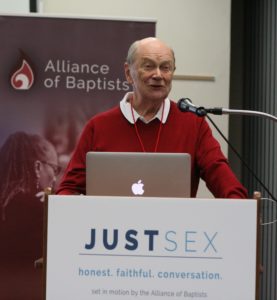Sexologist William Stayton said biology doesn’t support a literal interpretation of the story of Adam and Eve to explain the difference between the sexes last week at a JUST SEX Conference sponsored by the Alliance of Baptists.

William Stayton discusses sex and the Bible at the JUST SEX Conference. (Photo by Bob Allen)
Stayton, professor emeritus in the Center for Human Sexuality Studies at Widener University, said the same embryonic material develops in the womb into both male and female. Which depends on factors including whether the default progression toward an XX chromosome pair is switched off by the introduction of the Y chromosome from the male.
“Do you get the implications of that in terms of Genesis?” asked Stayton, an ordained American Baptist minister and one of the initiators of the JUST SEX Conference.
“It’s impossible in biology – and when you look at paleobiology – it’s impossible that males came first,” Stayton said. “God does not go against God’s own setup, if you will. Nature’s intention is always to produce a female, and you have to add something to weaken the system and make it a man.”
“That’s a really profound thing that we haven’t dealt with very well, especially with Genesis,” he said. “Actually, the pre-Hebrew religions were all female worldwide, and Genesis turns out to be the final putdown of women. That’s a very important teaching for us in working in this field.”
Stayton also discussed intersexuality, a condition where an individual is born with ambiguous genitalia, as “part of a spectrum” between male and female. Also known as atypical genitalia, the condition occurs approximately once in every 4,500 births.
Doctors once thought the humane solution to spare such children from being ostracized was to perform surgery to make them one sex or another, typically female, and for their parents to raise them as girls without telling them about their birth.
Stayton worked with one such family, he said, with a child born as “a true hermaphrodite.” Doctors originally told the mother the baby was male, but other specialists told her such children were better off being reared as female.
“The problems with Kelly growing up have been really phenomenal,” Stayton said. “As an adult today, Kelly has gone between wanting to kill herself one day and wanting to live the next day, and wanting to teach people the other days on this issue.”
Not knowing any different, Stayton said he used to advise parishioners dealing with intersexuality to go ahead with sex reassignment to girl. “That was the wrong thing to do, and I regretted it every day since,” he said. “That’s why I’m so fervent in teaching about intersexuality, because it’s part of a spectrum.”
“There is no binary male and female. We are all on a spectrum.”
“There is no binary male and female,” Stayton said. “We are all on a spectrum.”
“Even in this room, we’re all on a spectrum, and it’s important that we begin to see the matrix, the dimensions, the possibilities along that spectrum that we all are on, that it’s all normal.”
Regarding sexual orientation, Stayton introduced the Kinsey Scale, used in college textbooks ranging from zero for exclusively heterosexual to six for exclusively homosexual. Stayton said research indicates that 80 percent of people are somewhere in between.
‘Nature’s intention really is to produce a three,” he said. “The more repressive a society becomes, the more it reaches out to the bipolar opposites. The less repressive societies move into the two, three, four categories.”
“Over three quarters of the societies that have ever existed are in the non-repressive end,” he said. “On the repressive end, we are the second most repressive society in history.”
Stayton said based on his work, he believes the majority of clergy lie within the two, three and four categories, “which makes it possible for them to communicate better with both genders.”
“I think Jesus probably was a true three, and I think we can make a great case biblically for that,” he said.
The JUST SEX Conference, held at the Scarritt Bennett Center in Nashville, Tennessee, included worship, Bible study and breakout sessions to explore topics including how understandings of sexuality change over time and how faith communities can respond to those changes, as well as principles toward a contemporary sexual ethic reclaiming sex as a gift from God.
